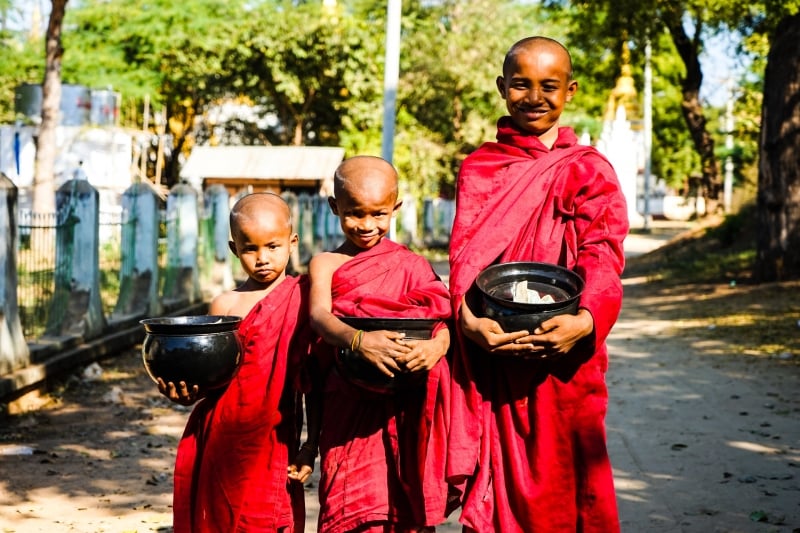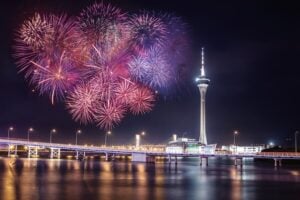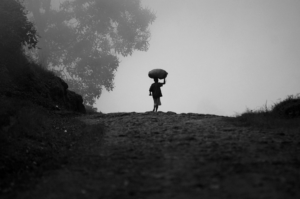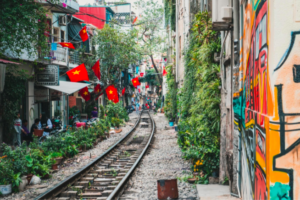Uncovering Myanmar’s unique brand of Buddhism
With almost 90 percent of the population identifying as Buddhist, Myanmar is one of the most devoutly Buddhist countries in the world. The “Land of Pagodas” has more than 56,000 monasteries, home to up to half a million monks and 50,000 nuns to go with an uncountable number of pagodas and temples. Myanmar Buddhism follows the more conservative Theravada branch practiced in Sri Lanka, Cambodia and Thailand, said to be closer to the original Indian form of Buddhism than the Mahayana Buddhism of China, Vietnam and Japan.
To find out more about the fascinating yet confounding brand of Myanmar Buddhism and the role it plays in the lives of everyday people, I head to the plains of Bagan, famously home to over 3,000 pagodas and temples, and where Buddhism became the national religion.
While records indicate that Buddhism was present in Myanmar as early as the third century before Christ, along with Hinduism, and animist beliefs, it wasn’t until the 11th century AD that Buddhism found a true champion in King Anawrahta, founder of the Pagan Empire.

Chronicles relate that Shin Arahan, a monk from Thaton in southern Myanmar, came to Anawrahta and converted him to Theravada Buddhism. To give legitimacy to his newfound faith, Anawrahta wanted to have the Tipitaka, or Buddhist Scriptures. When the Mon-speaking King Manuha of the Thaton Kingdom refused to hand them over, Anawrahta took them by force, conquering the kingdom and bringing back thirty sets of Tipitaka as well as King Manuha, his court, monks, artisans and craftsmen.
While in captivity, Manuha would also build a temple. I wander the structure and immediately notice that where other temples are grand, spacious affairs, Manuha’s features giant Buddha statues crammed in rooms barely large enough to hold them, linked by narrow passages where only one person can squeeze through at a time, a palpable expression of his own suffocating feelings towards life in captivity.
In addition to the Mon kingdoms in the Irrawaddy valley down to the Andaman Sea to the south, Anawrahta’s conquests included Arakan by the Bay of Bengal to the east, Nanzhao (present- day Yunnan in China) to the north and northern and central Thailand to the west, becoming the first to unify all the kingdoms into one country. Thanks to his economic reforms and engineering feats of irrigation, turning the otherwise arid plains of central Burma into a rice granary, the Kingdom of Pagan flourished, ushering in an era of frenzied construction of temples and pagodas that lasted nearly 250 years. It’s said that during the golden era of Pagan, even widows could afford to build religious monuments.
Anawrahta’s own contribution included the Shwezigon Pagoda, the first major monument built in Burmese style following the country’s conversion to Theravada Buddhism. He was able to finish three terraces before his death, each adorned with gorgeous green tiles depicting legends from the previous births of the Buddha.

3, 5 and 8
The number three reminded me of the three main practices in the life of a Myanmar Buddhist: merit, morality and meditation. In George Orwell’s Burmese Days, he says of his antagonist: “In his eyes his pile of merit was a kind of bank- deposit, everlastingly growing. Every fish set free in the river, every gift to a priest, was a step nearer Nirvana.” Everywhere I go in the country, I see acts of merit, ranging from the smallest—leaving out a water jug for thirsty travelers, hanging up a spray of millet for hungry birds, buying a bundle of flowering myrtle as a temple offering, adding a razor thin square of gold leaf to an image—to the epic— entering children into monastic life, making religious pilgrimages, or the most worthy of all, building a pagoda.
Anawrahta’s son completed Shwezigon with two more terraces, bringing the number to five. Every good Buddhist keeps the Five Precepts, exhortations not to kill, steal, lie, drink alcohol or commit adultery. Keeping them, though, involves certain, often humorous, contradictions. Advertising slogans try and convince people that beer isn’t really alcohol. “Buddha preached the Middle Way, somewhere in between indulgence and denial,” a man tells me with a shrug and a smile when I ask whether he imbibes. In markets, fish and other types of seafood are never sold alive so that the buyer doesn’t have to point to one and be complicit in its killing. The sin of butchering is left to non-Buddhist groups when possible or to unfortunate believers who were born to bad karma. Fishermen joke that they’re not killing the fish, but rather saving them from drowning.

Shwezigon’s terraces lead to an octagonal platform and a gilded stupa. The number 8 also has significance in Myanmar Buddhism. The Noble Eightfold Path teaches eight practices leading to Nirvana and instead of having 12 zodiac signs based on birth year like the Chinese, the Myanmar people recognize the eight days of the week when one is born (with two for those born on Wednesdays—morning and afternoon), each with its own planet, animal and direction, a concept borrowed from Hindi Brahman astrologers. One’s day of birth affects everything from what letter his name starts with and who he might be compatible with to where he worships, with each temple offering eight planetary posts where devotees pray and pour water over a Buddha image.
More uniquely, though, Myanmar Buddhism incorporates the reverence of nats, or spirits, often powerful people who died tragic or violent deaths in the belief that if they were powerful in this life then they will be powerful in the next. Anawrahta tried to replace this ancient animist belief system which in many ways is incompatible with Theravada Buddhism, some requiring offerings of animals or alcohol. In the end, the mighty king failed, so with the “if you can’t beat ‘em, join ‘em” mentality, he folded the worship of 37 “official” nats into the national religion, allowing them a place in the lower terraces of Shwezigon.
In a non-descript building tucked away in the corner of the temple, I find the statues of the nats adorned with gold bangles, neatly folded bills and other offerings. Nats are believed to be protectors of homes, villages, mountains, and forests, each with a different personality. For some Myanmar people, Buddhism is for the future life whereas the nats govern the present. There’s Shwe Saga, a nat who was always on time, therefore a favorite of office workers looking to curry favor with the boss. The young and young-at-heart gravitate towards Ko Gyi Kyaw, reputedly a carefree man in life who enjoyed women, gambling and cockfighting and whose festivals are celebrated with copious amounts of alcohol, dancing and all manner of vice.
Ever-Standing
I spend the rest of my time cycling the arid Bagan plain, wandering in a dreamscape of spires and stupas, what Somerset Maugham described as ‘looming huge, remote and mysterious, like the vague recollections of a fantastic dream.’ Originally built of wood and brick, only the brick monuments now remain, some with beautifully preserved murals and colorful ceramics. I visit the huge Dhammayangyi Temple, built by wicked King Narathu to atone for smothering his father, brother and one of his wives. It’s said that the king demanded the brickwork fit so tightly together using no visible mortar that if he could stick a pin between the bricks, he would cut off the hands of the unfortunate mason. I find a place where a doorway to the inner corridor looks to be sealed off, some say to trap his evil spirit inside. I also wander through Ananda Temple, often viewed as Bagan’s most beautiful, with its corridors filled with hundreds of tiny images housed in niches, and a giant Buddha statue with an expression that can be seen as serious or smiling, depending on whether you’re walking the inner corridor for monks or the outer corridor reserved for laymen.

In the courtyard of the graceful Sulamani Temple, I talk to Min who remembers playing hide-and-seek in the cool corridors and dark niches of the 1,000-year-old temples as a child. He also recalls finishing an evening game of football when a 6.5 magnitude earthquake struck in 1975, the worst in 900 years, and being enveloped in a cloud of dust as Thatbyinnyu, Bagan’s tallest temple crumbled not far from where he was playing. In August 2016, another earthquake struck, this time a 6.8 magnitude quake causing extensive damage to more than 400 monuments and pagodas.
Min leads me to the back of Sulamani Temple to see where the rubble has been cleared into three piles—original bricks, new bricks and a tangled pile of metal rebar. “See here? They used reinforced concrete to rebuild the pagoda!” he says with disbelief. He’s talking of the decade of frenzied renovation between 1995 and 2005 where new pagodas were built on top of old foundations or damaged pagodas were repaired using inauthentic materials and techniques. The pagodas are active sites of worship which mean the people of Myanmar often did what they thought was right—repainting, whitewashing over dingy but original murals, and beautifying exteriors as a form of merit-making without necessarily considering the importance of historically accurate preservation. Unsurprisingly, UNESCO cited poor management strategies as one of the reasons Bagan was rejected as a World Heritage Site in 1996. Even today, only a paltry two percent of the USD20 entrance fee goes towards temple conservation and maintenance.
The 1990s also saw Myanmar’s generals building hotels, roads, a golf course and a viewing tower too close to the temples. Min remembers all the families in what is now Old Bagan, the archaeological zone, being given just two weeks to move to a designated area, ostensibly so the government could conduct excavation work. “They moved us to a place that was just fields filled with snakes with no water or electricity,” remembers Min of what is now New Bagan. “People were supposed to get comparable locations, but many families didn’t have the money to re-build according to the high standards the government required, so whole neighborhoods were broken up. They later gave land use in Old Bagan to their cronies who owned hotels and restaurants but the people got nothing. My grandparents are still bitter,” he says.

Later, I find myself under a tamarind tree, the tinkling of temple bells in the wind, a guest at a feast of 30 dishes in honor of King Narathihapate, the last king of the Pagan Empire. Known as a glutton who regularly enjoyed meals of 300 dishes, Narathihapate is also known in Burmese history as “Taruk Pyay Min”, or “the King Who Fled from the Mongols.” It was under his rule that the Pagan Empire fell before advancing Mongol invasions in the time of Kublai Khan, ending nearly 250 years of building one of the greatest Buddhist sites in the world.
I begin to wonder how Myanmar Buddhist beliefs have influenced how the people dealt with decades of mistreatment under the military junta. I think of the reclining Buddha at the Manuha Temple, the only Buddha with a look of peace, pictured in the last moments of life on earth prior to entering Nirvana. His outstretched palm is empty, signifying that you can’t take anything with you, that materialism and greed don’t bring happiness. To Myanmar Buddhists, change is inevitable and this lifetime is but one among millions of rebirths until finally escaping earthly suffering and reaching Nirvana. If salvation can only be achieved from within, how important are outside influences? I ask Min what he thinks and he says simply, “Not hungry, not angry,” meaning that as long as people have enough to eat, it’s the Buddhist way to avoid stress and conflict.
I think about the people I’ve met throughout the country—humble farmers, sellers and students—people with very little in a material way, but who have welcomed me with ready smiles and a warmness I’ve never seen anywhere else. The Myanmar people are likened to pyit taing htaung, a traditional toy sold on temple steps—oval balls made of papier mâché and covered in gold foil with a painted smiley face. Meaning “ever-standing,” there’s a small dab of mud on the inside making them bottom- heavy. No matter how hard they’re thrown, they always manage to right themselves. I realize that it’s a beautiful comparison to the people of Myanmar whose beliefs have made them all pyit taing htaung, rising again and again in the face of hardship, ever standing, ever smiling.






